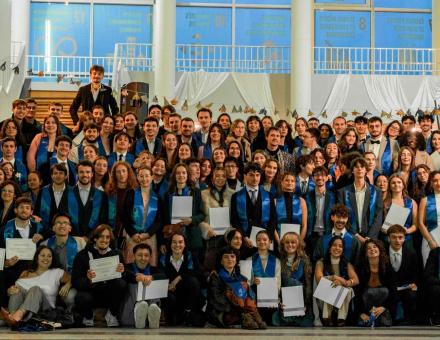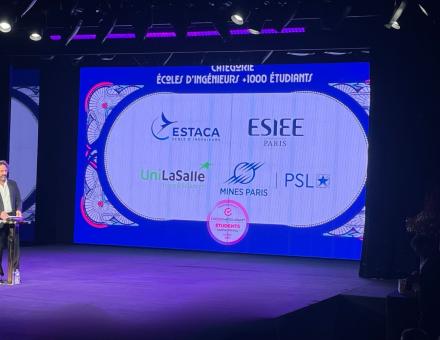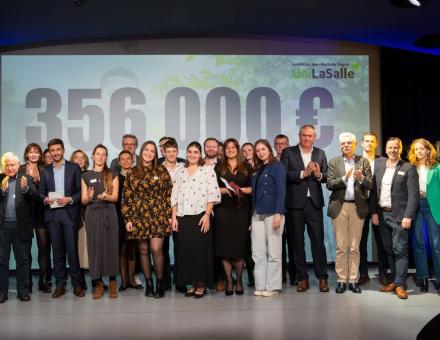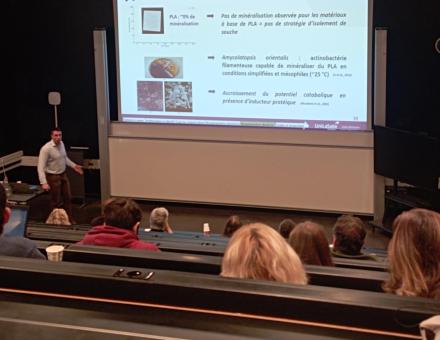On February 11, 2005, Law No. 2005-102 on equal rights and opportunities, participation, and citizenship for people with disabilities was adopted. Twenty years later, what is the situation regarding accessibility in higher education institutions?
The hearing of Xavier Quernin, Disability Officer at UniLaSalle and Institutional Disability Advocacy Coordinator at the CGE, Sophie Odone, Diversity and Inclusion Officer at the CGE, and Marc Sagot, Deputy General Delegate of the CGE in charge of external and parliamentary relations, on Wednesday, May 15, at the National Assembly at the invitation of MPs Christine Le Nabour and Sébastien Peytavie, is an opportunity to take stock of the issue in the member schools of the Conférence des Grandes Écoles.
Infrastructure, employability, international opportunities, student life... progress on all fronts!
The 2005 law paved the way for the first CGE disability charters to be signed with the Ministry of Higher Education and Research.
Since then, significant progress has been made in terms of accessibility to higher education for students with disabilities.
From a purely material point of view, most of the buildings and student accommodation of the member institutions of the Conférence des Grandes Écoles have been brought into compliance. The CGE Disability Barometer reveals that in 2019, 95.7% of its member schools were fully or partially accessible to people with reduced mobility. However, difficulties remain in older or listed buildings, which are subject to an exception. A new, more accurate assessment will be carried out shortly.
Significant efforts have also been made to improve access to digital tools and websites at institutions.
Teaching and support services such as university libraries and documentation centers have also seen a marked improvement. Specific actions have been taken to promote the international mobility of students with disabilities, both operationally through the creation of advisory boards and at the institutional level. The institutional advocacy of the Conférence des Grandes Écoles was born out of its desire to act on one of the hallmarks of the Grandes Écoles: international mobility. Supported by 100% Handinamique and Thransition, it has enabled solid progress in access to international mobility for students with disabilities, in particular through the appointment of the first disability advisors within French embassies abroad and the creation by the CGE of an international mobility grant, funded by TotalEnergies and Air Liquide, to cover additional costs related to disability that are not covered by other funding (technical aids, human support, adapted housing, etc.).
Flagship initiatives have been carried out to promote the employability of students with disabilities. In addition to adapting the language assessment process, which has had a positive impact on the graduation rates of young students with neurodevelopmental disorders (autism spectrum disorders, dyslexia, etc.) or sensory disabilities, these initiatives include connecting students with companies during job fairs, encouraging apprenticeships, and promoting the recruitment of people with disabilities. dyslexia, etc.) or sensory disabilities, these include connecting students with companies at job fairs, encouraging apprenticeships and internships, setting up Duo Days, and providing support for international mobility.
Access to student life has also been the focus of ongoing efforts by CGE member schools, which support the appointment of disability advisors in student associations. Practical information sheets produced by the Disability Working Group guide institutions in organizing inclusive student events.
This positive assessment reflects the commitment of the Grandes Écoles, which work hand in hand with external associations and organizations to continuously improve conditions for students with disabilities. Several collaborations support this inclusive dynamic. These include the long-standing partnership between the CGE's Disability Working Group and the associations THransition and 100% handinamique, which facilitate the sharing of best practices. In addition, an agreement signed between the CHE and the French Paralympic and Sports Committee (CPSF) aims to promote access to higher education for young people with disabilities, encourage them to participate in physical activity and achieve sporting success, and support the professional integration of former athletes through access to continuing education.
Invisible disabilities and mobility remain significant barriers to inclusion
Nevertheless, these improvements should not mask the existence of certain barriers.
There are still significant disparities between higher education institutions in the implementation of inclusive policies, mainly for two reasons: some of the ministries responsible for the grandes écoles have not signed the circulars on exam and competition accommodations for students with disabilities and on their rights, and the financial capacities of institutions remain very heterogeneous, with significant variations in funding.
From the students' point of view, interregional mobility, which is often necessary to continue their studies due to the concentration of training opportunities in large cities, involves restrictive accommodation requirements. This mobility also means being far from family and medical support, and therefore from a reassuring environment that guarantees proper treatment.
Many students also highlight the difficulty of getting their support and accommodation needs recognized. This obstacle could be explained by disparities between regions in terms of student health services (SSE) and the limited number of doctors approved by the Commission for the Rights and Autonomy of People with Disabilities (CDAPH), which leads Grandes Écoles to base their choices of accommodations on information provided by secondary schools. On this point, the CGE emphasizes the importance of recognizing the expertise of its member institutions' disability advisors in defining needs, in addition to the MDPH, and the need to provide them with further training, particularly in the handling of sensitive data.
All these obstacles can lead to self-censorship. Particular attention must be paid to students with invisible disabilities, who may find it difficult to report their needs for fear of being stereotyped. Certain types of disability are still subject to some problems of recognition (dys disorders, psychological disorders, disabling illnesses, etc.) or even a lack of awareness on the part of institutions, such as psychological disorders or autism spectrum disorders.
Communication, a lever for progress
This self-censorship may also be fueled by a lack of communication from schools about their inclusivity and their knowledge of all types of disabilities and how they are accommodated, which is essential for establishing a climate of trust on this subject.
Certain levers for progress have already been activated within the CGE's Disability Working Group, notably through agreements with parents' associations such as APEL and PEEP, enabling meetings to be organized to present the compensation and support available in higher education. Other possibilities could be explored, such as the introduction of secondary/higher education DuoDays organized by the association 100% handinamique, or the renewal of the Phares and Phratrie schemes.
Better information on the regulations in force and on the support offered by higher education institutions on the Parcoursup platform would also help to remove some of the barriers to self-censorship that often arise between secondary and higher education.






